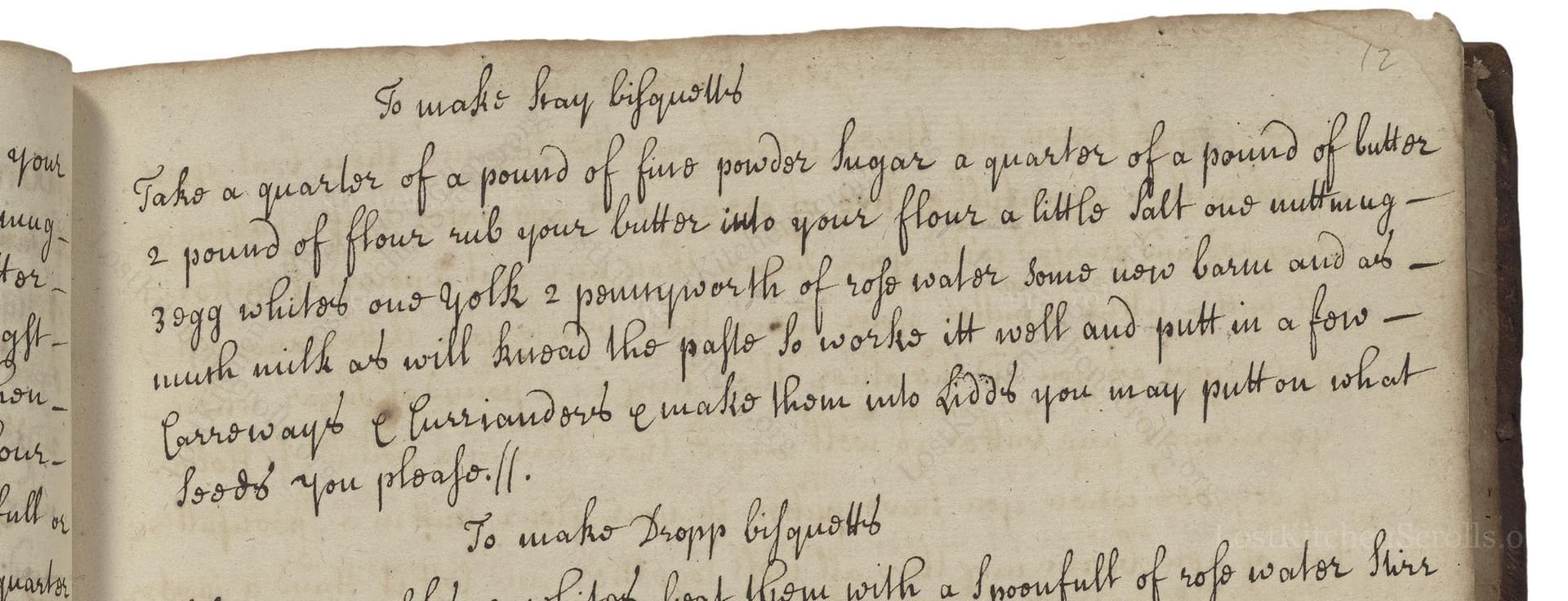To Make Iray Bisquollt
From the treasured pages of Mrs. Rachel Kirk Book 1707
Written by Rachel Kirk

To Make Iray Bisquollt
"Take a quarter of a pound of fine powder sugar a quarter of a pound of butterr 2 pound of flour rub your butterr into your flour a little salt one nutmeg- 3 egg whites one yolk 2 pennyworth of rose water some new barm and as- much milk as will knead the paste to worke itt well and putt in a few- Carroways & Currianders & make them into seeds you may putt on what seeds you please.//"
Note on the Original Text
This recipe, as many from the early 18th century, employs a conversational and instructive tone rather than a step-by-step format. Measurements are often imprecise ('as much milk as will knead the paste'), reflecting a reliance on the cook's experience and intuition. Spellings like 'barm' (for frothy yeast), 'Iray bisquollt', and 'Currianders' are typical of the non-standardized English of the time. The instruction to 'put on what seeds you please' shows a flexibility and personalization common in manuscript cookery.

Title
Mrs. Rachel Kirk Book 1707 (1707)
You can also click the book image above to peruse the original tome
Writer
Rachel Kirk
Era
1707
Publisher
Unknown
Background
A remarkable collection of early 18th-century recipes, Rachel Kirk's work invites readers into the kitchens of the past where classic culinary traditions and timeless flavors come alive. Expect a charming medley of savory feasts and sweet treats reflective of the era's sophisticated palate.
Kindly made available by
Folger Shakespeare Library
Iray Bisquollt is a charming recipe hailing from the early 18th-century kitchen of Rachel Kirk, as transcribed in 1707. It reflects the British fascination with sweet, spiced biscuits and buns of the era—satisfying both as a teatime treat and an everyday delicacy. The inclusion of rose water and aromatic seeds like caraway and coriander reveals a love for fragrant, exotic flavors in early modern English baking. The use of 'barm', or brewer's yeast, situates the recipe in a time before commercial yeast, when such leavening was drawn from brewing.

Back in 1707, Iray Bisquollt would have been made using a large earthenware or wooden bowl for mixing, wooden spoons for stirring, and hands for kneading. The baker would likely use a hand-held grater for the nutmeg, and kitchen sieves to ensure the sugar and flour were finely powdered. The dough would rise near a hearth or a warm spot in the kitchen, and the biscuits would be baked in a wood-fired oven on iron or tin baking sheets lined with paper or sprinkled with flour.
Prep Time
30 mins
Cook Time
15 mins
Servings
24
We've done our best to adapt this historical recipe for modern kitchens, but some details may still need refinement. We warmly welcome feedback from fellow cooks and culinary historians — your insights support the entire community!
Ingredients
- 4 oz (1/2 cup) fine powdered sugar
- 4 oz (1/2 cup) unsalted butter (softened)
- 2 lb (about 7 1/4 cups) plain wheat flour
- Pinch of salt
- 1 whole nutmeg, grated (about 2 tsp or 0.07 oz)
- 3 egg whites
- 1 egg yolk
- 2 tsp (about 2/3 tablespoon) rose water
- 2 tsp (2/3 tablespoon) fresh yeast (or 1/4 oz active dry yeast dissolved in warm milk as substitute for 'barm')
- 1/2–3/4 cup fresh whole milk
- 2 tsp caraway seeds
- 2 tsp coriander seeds
- Additional seeds of choice, to taste
Instructions
- To make Iray Bisquollt with modern ingredients, begin by creaming together 4 oz (1/2 cup) of fine powdered sugar with 4 oz (1/2 cup) of softened butter.
- In a large bowl, rub the butter mixture into 2 lb (about 7 1/4 cups) of plain wheat flour along with a pinch of salt and the finely grated zest of one nutmeg.
- Separately, lightly beat three egg whites and one egg yolk, then add these to the flour mixture.
- Stir in 2 teaspoons (about 2/3 tablespoon) of rose water and 2 teaspoons (2/3 tablespoon) of fresh yeast (or 1/4 oz active dry yeast dissolved in a little warm milk).
- Mix in a handful—about 2 teaspoons each—of caraway and coriander seeds, or substitute with seeds of your choice.
- Gradually add enough warm milk (start with 1/2 cup and add more as needed) to form a soft but workable dough.
- Knead well until smooth and elastic.
- Let the dough rise in a warm place until slightly puffed (about 1 hour).
- Shape into small rolls or biscuits, sprinkle with extra seeds if desired, and let rise briefly again.
- Bake at 350°F until golden, about 12-18 minutes.
- Cool on a rack and serve with tea or as a snack.
Estimated Calories
160 per serving
Cooking Estimates
Preparing and shaping the dough takes around 30 minutes, then baking takes about 15 minutes. This recipe makes about 24 biscuits, and each has about 160 calories.
As noted above, we have made our best effort to translate and adapt this historical recipe for modern kitchens, taking into account ingredients nowadays, cooking techniques, measurements, and so on. However, historical recipes often contain assumptions that require interpretation.
We'd love for anyone to help improve these adaptations. Community contributions are highly welcome. If you have suggestions, corrections, or cooking tips based on your experience with this recipe, please share them below.
Join the Discussion
Rate This Recipe

Den Bockfisch In Einer Fleisch Suppen Zu Kochen
This recipe hails from a German manuscript cookbook compiled in 1696, a time whe...

Die Grieß Nudlen Zumachen
This recipe comes from a rather mysterious manuscript cookbook, penned anonymous...

Ein Boudain
This recipe comes from an anonymous German-language manuscript cookbook from 169...

Ein Gesaltzen Citroni
This recipe, dating from 1696, comes from an extensive anonymous German cookbook...
Browse our complete collection of time-honored recipes



